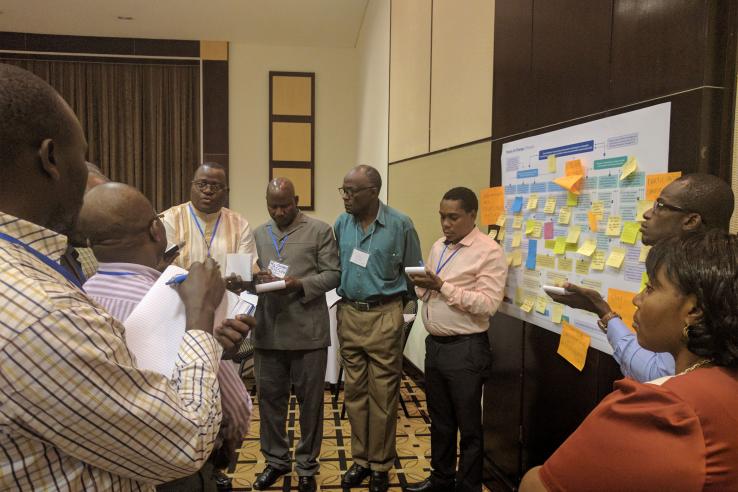Why aren’t farmers using improved agricultural technologies to increase their profits? Lessons from ten years of research in the Agricultural Technology Adoption Initiative

This blog was cross-posted from the Center for Effective Global Action (CEGA) blog.
How can we improve the profits and welfare of smallholder farmers who make up a majority of the world’s poorest people? These questions aren’t new and (perhaps unsurprisingly) it’s complicated.
But it’s clear from FAOSTAT data that agricultural production in sub-Saharan Africa (and to some extent South Asia) remains far below the technological frontier. This suggests missed potential in terms of yields, income, and welfare benefits for many living in poverty.
With this in mind, policymakers need to understand what prevents farmers from adopting technologies and effectively accessing markets, and which approaches improve farmers’ livelihoods.
What we’ve done
We’ve distilled lessons from a decade of rigorous experimentation, including dozens of randomized evaluations across sub-Saharan Africa and South Asia—predominantly those that were competitively selected for funding by J-PAL and CEGA's joint Agricultural Technology Adoption Initiative (ATAI).
These evaluations go beyond counting farmers “engaged”—they identify the effectiveness of specific approaches in shifting farmers’ real-world choices, and measure whether or not (or to what extent) that specific intervention can change farmers’ yields or profits.
The core contribution of randomized evaluations is this ability to clearly trace causality. Carefully designed experiments allow us to (1) test whether specific constraints are holding farmers back (access to credit, risk protection, input or output market access, etc.), and (2) measure the real-world impacts of a technology when adopted in farmers’ actual fields.
The methodology is one valuable tool for testing important hypotheses, and critically examining common assumptions of what works and why.
Governments in Africa and Asia, as well as multilateral policy advisory units, have requested presentations of these insights to inform real-world policy recommendations (e.g. in partnership with FAO-MAFAP to inform ministries in Uganda).
Specific findings have impacted the operations of existing government agricultural programs (scaling improved rice in Odisha) and inspired the founding of new organizations to better support farmers (mobile phone-based agricultural extension; post-harvest storage loans).
What have we learned so far?
Smallholder farmers in rainfed contexts face a range of constraints that limit the modernization of agriculture. Challenges, such as water control and variable prices, make it particularly difficult for farmers to observe, manage, or predict conditions that are key to profitable farm investments in remote markets.
We see that:
- Risk mitigation is key for supporting smallholders in rainfed contexts, but solving risk constraints within agriculture is difficult. We discuss takeaways for both insurance design and risk-mitigating crop varieties, noting that combinations of these weather-protective approaches are the focus of ongoing evaluations.
- Formal credit markets appear too high-risk and low-return to develop in a way that reaches smallholders without supportive investments in creative, targeted product design and financial institutions. We discuss early signs of promising financial service designs, as well as common pitfalls to address.
- Logistics matter: quite clearly, the specific mechanism by which credit, insurance, or information is delivered has significant influence on its effectiveness. Behavioral economics also provides an important product design lens, and we touch on implications throughout the discussion.
- The local variation of agro-ecological and market conditions can hinder farmers’ learning from their peers. This diversity of conditions can also mean that not all farmers have the necessary complementary factors to reap returns from a particular technology, and reliable access to quality, context-attuned technologies should not be assumed.
- Information is only useful to the degree that it is both novel and profitably actionable, and business-as-usual extension is often ineffective. In cases where information is novel, timely, tailored, and also actionable, we have seen positive impacts (see our summary on VoxDev).
- There does appear to be some efficiency gains from price notification systems with welfare benefits for some farmers. Where this can be delivered inexpensively, the resulting convergence of prices across markets may well be cost-effective. However, price information alone is unlikely to be enough to access significantly more profitable points of sale or transform market conditions.
- Small-scale producers may not profit from adopting productivity-or quality-enhancing technologies under current output market conditions. There is scope to improve producer contracts and enhance the flow of information, to provide sufficient incentives for farmers to invest in greater crop quantity or quality. But scaling controlled pilots to sustained institutional models is difficult, making this an important area for future testing.
What’s next?
So far, only a handful of impact evaluations have directly tested interventions designed to fundamentally shift agricultural input and output markets. Farmers’ relationships with market intermediaries (agrodealers, traders, etc.) vary across contexts, as do the costs of doing business. Both affect how value chains are structured and whether and how favorable prices (or other benefits like credit) pass-through to farmers.
There is important work to be done to understand the costs of infrastructure, competition among value chain intermediaries, the potential for contract farming and other market linkage arrangements, and how value chain actors respond to market reforms designed to improve input and output quality in supply chains. We are continuing to build the evidence base to better fill these gaps by shifting our focus towards “agricultural transformation.”
Read a previous post on ATAI’s renewal, and read ATAI’s Framing Paper and de Janvry & Sadoulet (2020) for a discussion of moving beyond technology adoption to an agricultural transformation research agenda.
